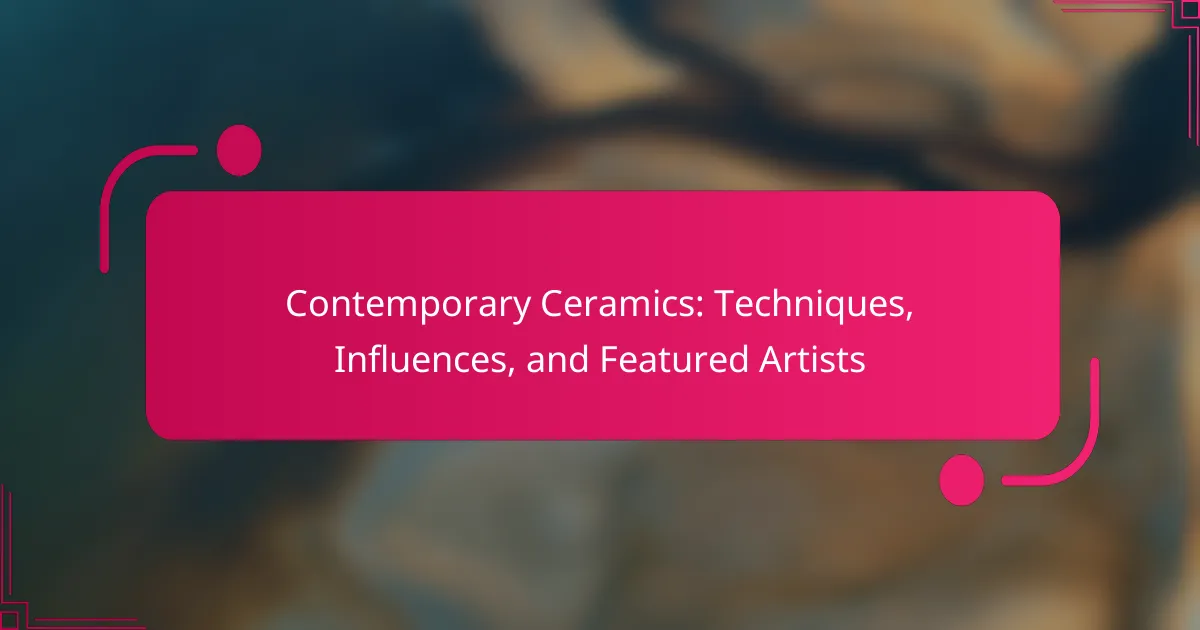Contemporary ceramics offer a rich exploration of techniques, influences, and artistic expressions. This article examines hand-building and wheel-throwing methods, the impact of cultural traditions and modern art movements, and the innovative works of featured artists like Grayson Perry and Magdalene Odundo. Understanding these elements enhances appreciation for the evolving landscape of modern ceramic art.
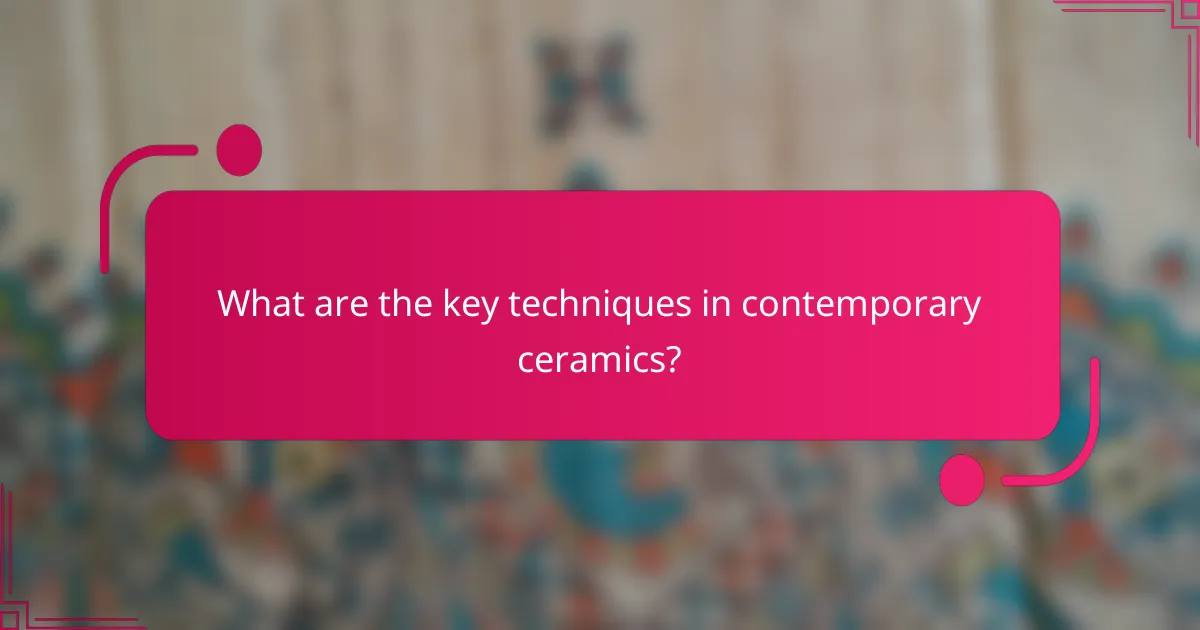
What are the key techniques in contemporary ceramics?
Contemporary ceramics incorporates techniques such as hand-building, wheel-throwing, glazing, and firing methods. These techniques reflect diverse influences from cultural traditions and modern art movements.
Hand-building allows for unique forms and textures, while wheel-throwing offers precision and symmetry. Glazing techniques enhance aesthetics and functionality, with options ranging from matte to glossy finishes. Firing methods, including electric, gas, and wood firing, impact the final appearance and durability of the pieces.
Featured artists often experiment with these techniques, pushing boundaries and creating innovative works. Their contributions highlight the evolving nature of contemporary ceramics, merging traditional craftsmanship with contemporary design.
How does hand-building differ from wheel-throwing?
Hand-building and wheel-throwing are distinct techniques in ceramics. Hand-building involves shaping clay by hand, allowing for unique forms and textures, while wheel-throwing utilizes a potter’s wheel for uniformity and speed.
Hand-building offers greater creative freedom, suitable for intricate designs, while wheel-throwing emphasizes precision and efficiency. Each method influences the final aesthetic and functionality of ceramic pieces, catering to different artistic preferences and project requirements.
Hand-building techniques include pinch pots, coil building, and slab construction, whereas wheel-throwing primarily focuses on centering clay and shaping it into symmetrical forms. Both methods contribute to the diverse landscape of contemporary ceramics.
What role does glazing play in ceramic art?
Glazing plays a crucial role in contemporary ceramic art by enhancing aesthetics and functionality. It adds color, texture, and a protective layer to ceramic pieces, influencing their visual appeal and durability. Different glazing techniques can create unique finishes, such as glossy, matte, or textured surfaces, allowing artists to express their creativity. Additionally, glazes can affect the interaction of light with the ceramic, enhancing the overall artistic experience. The choice of glaze reflects the artist’s intention and can significantly alter the perception of the artwork.
Which firing methods are most popular among contemporary artists?
Contemporary artists commonly utilize methods such as wheel throwing, hand-building, and slip casting. Wheel throwing allows for precision and control, while hand-building emphasizes creativity and personal expression. Slip casting is popular for producing intricate shapes and uniformity. Each method has unique characteristics that influence the final artwork.
How do artists incorporate mixed media into ceramics?
Artists incorporate mixed media into ceramics by blending various materials and techniques to enhance their creative expression. This approach allows for the integration of textures, colors, and forms that traditional ceramics might not achieve.
For instance, artists may use materials like glass, metal, or found objects alongside clay to create unique pieces. The combination of these elements can result in innovative designs that challenge conventional boundaries. Additionally, techniques such as slip casting, glazing, and surface treatments further expand the possibilities of mixed media in ceramics.
This practice not only enriches the aesthetic appeal but also conveys deeper narratives and concepts, making each piece a distinct statement. Artists like Grayson Perry exemplify this integration, using mixed media to explore themes of identity and culture.
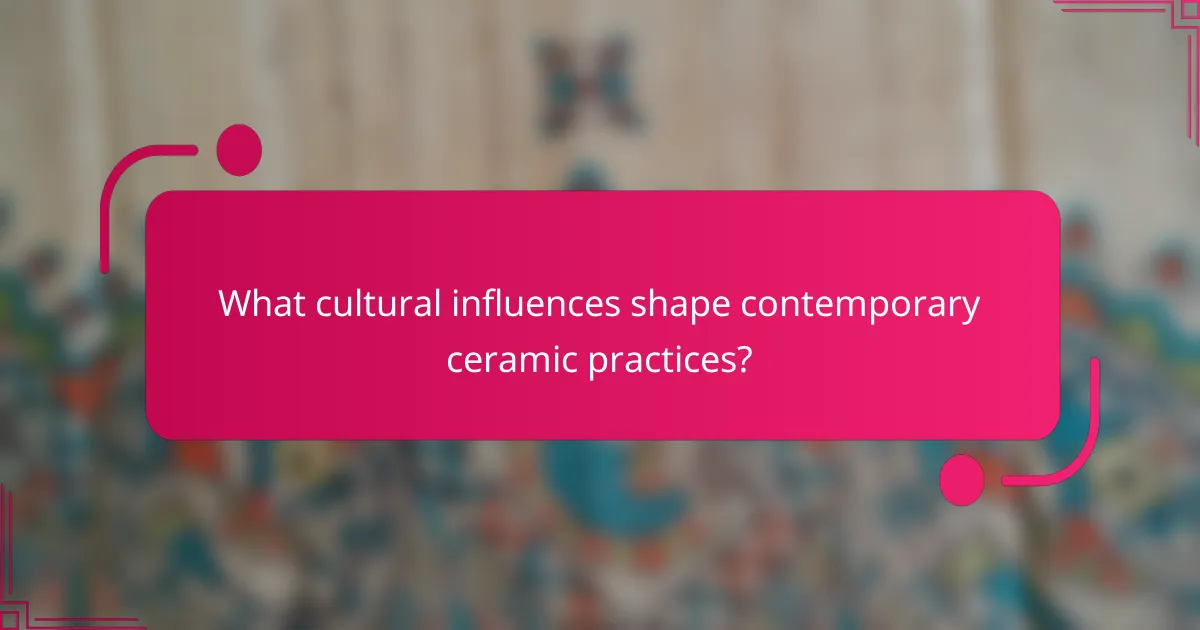
What cultural influences shape contemporary ceramic practices?
Cultural influences such as globalization, traditional practices, and contemporary art movements shape contemporary ceramic practices. Globalization introduces diverse techniques and aesthetics, while traditional practices inform craftsmanship and cultural narratives. Contemporary art movements challenge conventions, encouraging innovation and personal expression among artists.
How does traditional craftsmanship influence modern designs?
Traditional craftsmanship significantly shapes modern designs by integrating time-honoured techniques and aesthetics. Contemporary ceramics often reflect this influence through the use of hand-built methods, glazing techniques, and organic forms rooted in historical practices. Artists like Grayson Perry and Magdalene Odundo exemplify this connection, blending traditional motifs with innovative concepts. As a result, modern ceramics not only preserve cultural heritage but also challenge contemporary design narratives, creating a dialogue between past and present.
Which global movements are impacting ceramic art today?
Global movements impacting ceramic art today include sustainability, technology integration, and cultural exchange. Sustainability emphasizes eco-friendly materials and practices, pushing artists to innovate. Technology integration introduces digital tools for design and production, enhancing creativity. Cultural exchange fosters collaboration among artists worldwide, enriching artistic expressions and techniques.
How do local materials affect ceramic styles in different regions?
Local materials significantly influence ceramic styles, shaping aesthetics and techniques unique to each region. Different clays, minerals, and natural resources determine colour, texture, and durability of ceramics. For instance, high iron content in clay can produce red-toned pottery, while local wood ash may be used for glazing, resulting in distinctive surface finishes. These regional characteristics create a diverse landscape of contemporary ceramics that reflect local identities and traditions.

Who are the leading figures in contemporary ceramics?
Leading figures in contemporary ceramics include artists who push boundaries and innovate techniques. Notable names are Grayson Perry, known for his narrative-driven works; Magdalene Odundo, celebrated for her sculptural forms; and Ai Weiwei, who incorporates political commentary into his pieces. Their unique approaches highlight the diverse influences shaping modern ceramic art.
What are the notable works of emerging ceramic artists?
Emerging ceramic artists are making significant contributions with innovative works that challenge traditional techniques. Notable artists include:
1. Jae Won Lee – Known for her intricate porcelain sculptures that explore cultural narratives.
2. Ben Medansky – Combines functional pottery with sculptural elements, emphasizing texture and form.
3. Kelsey Montague – Creates large-scale installations that engage viewers through interactive ceramic pieces.
4. Ian McDonald – Focuses on the interplay of colour and glaze, producing vibrant, contemporary tableware.
5. Kimi Watanabe – Blends Japanese aesthetics with modern design, showcasing minimalistic yet expressive forms.
These artists exemplify the diverse influences and techniques shaping contemporary ceramics today.
Which established artists are redefining ceramic art?
Several established artists are redefining ceramic art today, including Grayson Perry, Ai Weiwei, and Magdalene Odundo. Grayson Perry blends traditional techniques with contemporary themes, exploring identity and society. Ai Weiwei uses ceramics to comment on cultural heritage and political issues, often incorporating historical Chinese forms. Magdalene Odundo emphasizes the human connection through her sculptural forms, reflecting on cultural narratives and personal history. Each artist uniquely contributes to the evolution of ceramic art, pushing boundaries and challenging perceptions.
How do artist collectives influence the ceramic community?
Artist collectives significantly enhance the ceramic community by fostering collaboration and innovation. They create spaces for artists to share techniques, resources, and ideas, leading to diverse artistic expressions. Collectives often host exhibitions and workshops that promote contemporary ceramics, making art more accessible. This collaborative environment nurtures emerging artists, allowing them to gain visibility and connect with established figures in the field. Additionally, collectives can influence trends by collectively exploring new materials and methods, pushing the boundaries of traditional ceramics.
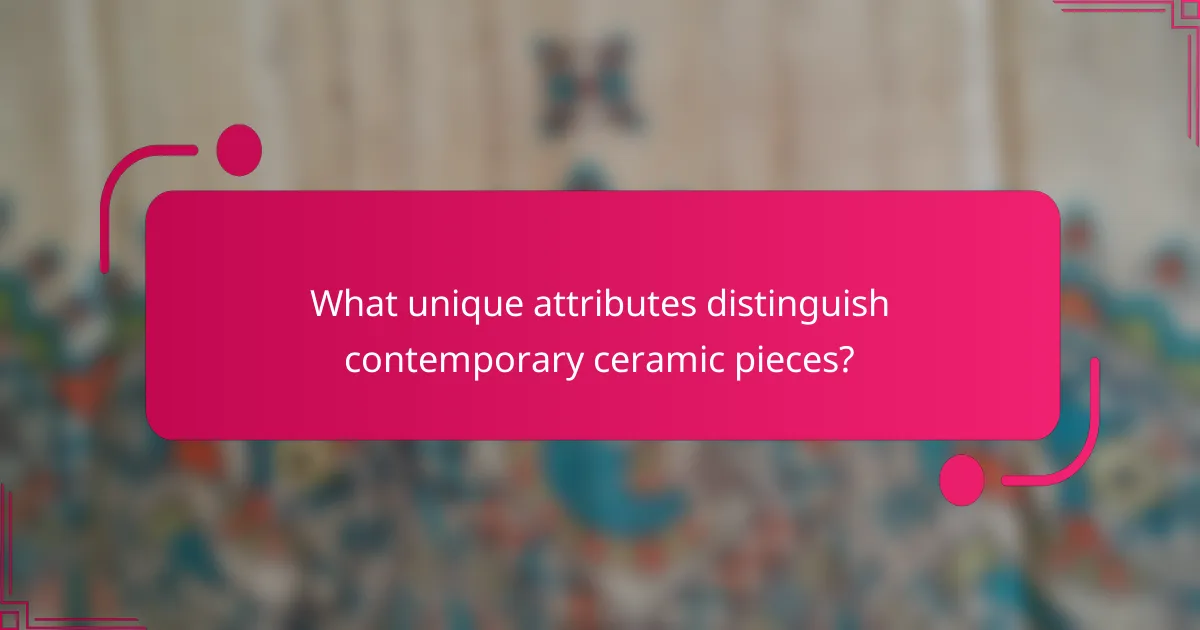
What unique attributes distinguish contemporary ceramic pieces?
Contemporary ceramic pieces are distinguished by their innovative techniques, diverse influences, and unique artistic expressions. Unique attributes include the use of mixed media, unconventional forms, and experimental glazing methods. Artists often draw inspiration from cultural narratives, environmental themes, and personal experiences, resulting in distinctive works that challenge traditional boundaries. The integration of technology, such as 3D printing, further sets contemporary ceramics apart, allowing for unprecedented design possibilities.
How does the use of technology enhance ceramic creation?
Technology significantly enhances ceramic creation by improving precision, efficiency, and creativity. Advanced tools like 3D printing allow artists to experiment with complex designs, enabling unique expressions. Digital modeling software streamlines the design process, while automated kilns ensure consistent firing temperatures. These innovations expand the possibilities of form, texture, and colour in contemporary ceramics.
What role does sustainability play in modern ceramics?
Sustainability is crucial in modern ceramics, influencing materials, techniques, and design. Artists increasingly prioritise eco-friendly practices, opting for natural clays and glazes. This shift reduces environmental impact and promotes resource conservation. Innovative techniques, such as using recycled materials, exemplify this commitment. As a result, contemporary ceramics reflect a growing awareness of ecological responsibilities.
Which rare techniques are being revived by contemporary artists?
Contemporary artists are reviving rare ceramics techniques such as raku, slip casting, and sgraffito. These methods emphasize unique textures and finishes, showcasing individuality in modern works. Raku, for instance, involves rapid firing and cooling, creating unpredictable colour patterns. Slip casting allows intricate designs through liquid clay, while sgraffito combines carving and glazing for distinct surface effects.
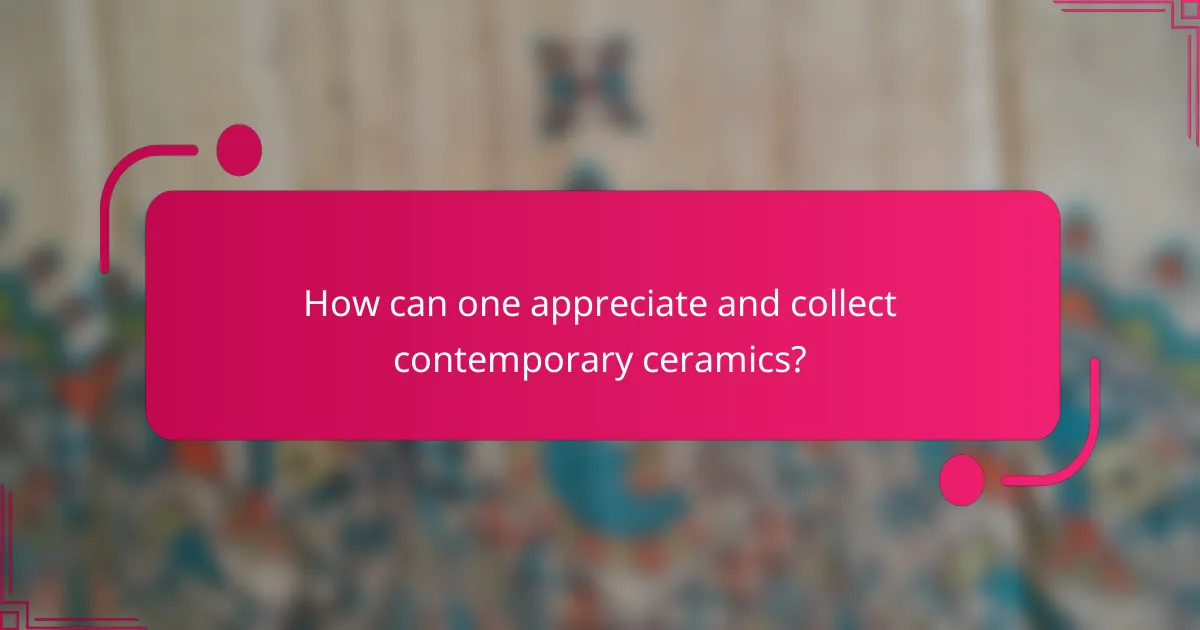
How can one appreciate and collect contemporary ceramics?
To appreciate and collect contemporary ceramics, immerse yourself in the techniques, influences, and featured artists. Understanding various methods such as wheel throwing and hand-building enhances appreciation. Explore the cultural and artistic influences shaping contemporary ceramics, including minimalism and organic forms. Discover prominent artists like Grayson Perry and Jennifer Lee, whose unique styles and innovative approaches contribute to the field. Engaging with local galleries and exhibitions can further enrich your collection experience.
What factors should collectors consider when purchasing ceramic art?
Collectors should consider authenticity, artist reputation, craftsmanship, and condition when purchasing ceramic art. Authenticity ensures the piece is original, while the artist’s reputation can influence value. Craftsmanship reflects the skill involved, impacting aesthetics and durability. Condition affects both value and enjoyment.
Additionally, collectors should evaluate the historical context of the piece. Understanding the influences behind the work can enhance appreciation and inform potential future value. Finally, considering the rarity of the piece can also play a significant role in its desirability and investment potential.
How can one assess the value of a ceramic piece?
To assess the value of a ceramic piece, consider its craftsmanship, historical significance, and market demand. Craftsmanship includes the quality of materials and techniques used, such as glazing and firing methods. Historical significance relates to the artist’s reputation and the piece’s origin. Market demand reflects current trends and collector interest. Each of these factors contributes to the overall valuation of contemporary ceramics.
What are the best practices for caring for ceramic art?
To care for ceramic art effectively, avoid extreme temperature changes and direct sunlight. Clean ceramics gently with a soft cloth and mild soap. Store pieces in a stable environment to prevent chipping or cracking. Regular inspection for damage helps maintain their condition.
What common mistakes should new collectors avoid?
New collectors should avoid overpaying, neglecting research, and following trends blindly.
Overestimating the value of pieces can lead to significant financial loss. Researching artists, techniques, and market trends is essential for informed decisions. Additionally, focusing solely on current trends may result in a collection that lacks personal significance or long-term value. Engaging with the ceramics community can provide insights and guidance, helping to refine collecting strategies.
